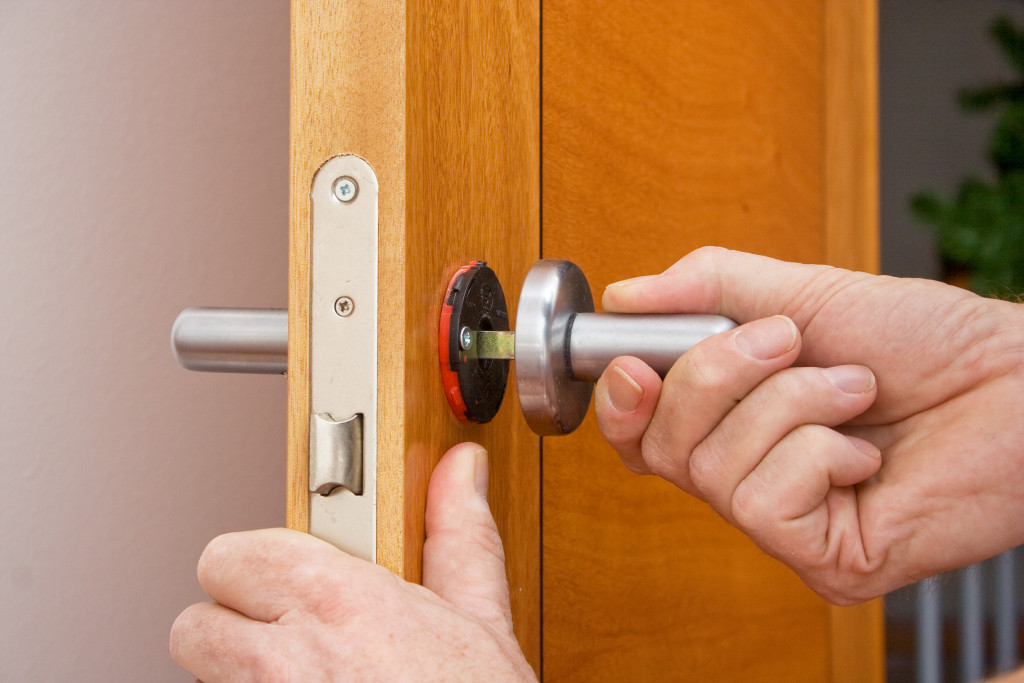- Establish a robust fire safety plan, including smoke alarms and regular fire drills.
- Secure all entry points with sturdy locks and consider installing a security system or smart doorbell for surveillance.
- Safeguard against common household hazards such as electrical, fire, poisonous substances, falling objects and choking hazards.
- Educate family members on digital safety and set up parental controls.
- Regularly check for property certificates to ensure safety standards are met.
The safety of your loved ones remains at the forefront of your priorities, especially within the confines of your home. While your home is meant to be a sanctuary, potential hazards can lurk in unexpected places. Being proactive and aware can transform these havens into truly secure places. Here are the essential steps you should take to ensure the safety and well-being of your family members.
1. Establish a Robust Fire Safety Plan
Fire safety is a paramount concern in any home.
Firstly, ensure you have working smoke alarms on every floor, ideally in each bedroom. Regularly test these alarms and replace their batteries annually. Remember, these devices can be the first warning signs of a potential fire.
Secondly, educate your family about safe practices, such as not leaving candles unattended and keeping flammable items away from heat sources. Hold fire drills to ensure everyone knows the quickest and safest way out of the house in an emergency.
2. Secure Entry Points and Windows

A safe home keeps unwanted intruders out.
Initially, assess the locks on all doors leading outside. Reinforce doors with deadbolts and consider installing a security system or smart doorbell to provide real-time surveillance.
Furthermore, windows can be potential entry points for burglars. Ensure all windows have sturdy locks, and consider installing window sensors that alert you when they’re opened.
3. Safeguard Against Common Household Hazards
Everyday objects in your home, such as kitchen utensils, electrical appliances, and furniture, can occasionally present unexpected dangers. It’s important to be aware of potential hazards and take necessary precautions to ensure the safety of yourself and your loved ones.
Here are some common household hazards:
Electrical Hazards
Electrical hazards are a common concern in many homes. Overloaded outlets, faulty wiring, and misuse of electrical appliances can all lead to dangerous situations. Ensure that all appliances are in good working order and used correctly. Never overload outlets, and always replace damaged cords immediately. Regular inspections by a certified electrician can help identify potential hazards early.
Fire Hazards
Fire hazards are present in almost every household. Flammable materials, such as candles, cooking appliances, and heaters, should be used cautiously. Ensure you have working smoke detectors on every floor and in every bedroom of your house. Regular testing and maintenance of these devices is crucial. Always have a fire extinguisher and ensure all family members know how to use it.
Poisonous Substances

Many household cleaning products and pesticides contain chemicals that can be hazardous if ingested or come into contact with skin. Always store these substances securely, out of reach of children and pets. Read and follow the manufacturer’s instructions for use and disposal. Consider using eco-friendly alternatives when possible.
Falling Objects
Furniture, such as bookshelves, wardrobes, and televisions, can pose a risk of injury if they topple over. Secure heavy furniture to the wall using brackets or anchors. Regularly check these fixtures to ensure they remain safe and stable. Keep heavier items at the bottom of shelves to prevent them from tipping over.
Choking Hazards
Small objects or toys can pose potential choking hazards, particularly for young children. Be vigilant about what items are within a child’s reach and regularly inspect their environment for small, easily ingestible items. Foods such as grapes, popcorn, and hot dogs should be cut into small, manageable pieces for children to avoid choking. Additionally, always supervise children while eating or playing.
4. Educate on Digital Safety
In this digital age, threats don’t just come from the physical world.
Initially, educate your children about the potential dangers of the internet. Ensure they know not to share personal information online and approach online friendships cautiously.
Moreover, set up parental controls on devices your children use. This restricts them from accessing inappropriate content and can limit screen time, ensuring they engage in other beneficial activities.
5. Regularly Check for Property Certificates
Your home’s infrastructure should be regularly reviewed to meet safety standards.
Firstly, utilizing professional property certificates is invaluable in ascertaining the safety and compliance of different aspects of your home, from electrical installations to gas safety. These certificates are essential for landlords and homeowners keen on ensuring their homes are safe.
Additionally, be proactive. If you notice any potential issues, such as a flickering light or a malfunctioning appliance, don’t wait. Hire professionals to inspect and certify the safety of various installations in your home. This proactive approach can help prevent minor issues from becoming major hazards.
In Summary
Ensuring the safety of your home is an ongoing process that requires attention, education, and, sometimes, professional intervention. By setting robust fire safety practices, securing entry points, being aware of household hazards, staying digitally safe, and regularly reviewing professional property certificates, you’ll cultivate a home environment where every family member can feel truly secure. Safety isn’t a one-time action—it’s a way of life.




